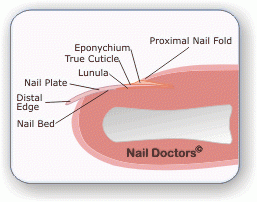Nails are constantly maturing, but their rate of growth slows down with age and inadequate circulation. Toe nails are known to grow much more slowly, in comparison to the swift developing Fingers nails. A half of a year length of time can be expected for a natural nail to grow to the edge from the root. Having an understanding of how quick or slowly the natural nail grows is vital when carrying out easy nail art designs.
It can take upwards of a year and a half for toenails to completely grow back, given that they grow at merely 1mm per month. The nail is made up of six specific parts, this is also known as the structure of the nail. A nails six area's are known as the more popular terms such as the nail cuticle, root and nail bed, as well as the nail plate, the perionychium and the hyponychium. All of these six elements of the nail features its own unique purpose and function. If any of these six areas undergo hurt, either through actual damage or an infection, then a nail abnormality will soon show up. A nail industry tech ought to be able to supply you with promises of easy nail art needs to have an excellent knowledge of nail anatomy.

The nail is a significant structure which is made of keratin and has two functions. Nails act as a defensive coating to the finger tip, and in addition offers and improves the sensation we experience inside the finger tip. Many people think that the nail acts only as a protecting function, without thinking about the sensation developments. The finger tip has loads of numerous nerve endings, that allows it to soak up details about things it touches, providing the sense of touch. A nail acts as a counter force to produce the tips of your fingers all the more sensory input when coming in contact with any item.
The eponychium shall be discussed next.
The cuticle is the skin which is located at the lower nail plate and fuses the two components with each other. The cuticle grows to offer a coating of defense to the nail from water. This can help to lower bacterial infections.
When performing any kind of nail treatment it is very important push back any cuticle which has developed too far onto the nail plate. Failure to do so will lead to an bumpy surface area, and messy final results. When pushing back the nail cuticle, you must go steady. By pushing the cuticle too far, something that is easy to do if you are rough, you are unveiling your finger nail to infections. You need to only remove any extra skin from your cuticle. Never remove healthy cuticle, because this again will leave the nail available to infection.
Regular usage of a cuticle oil is essential because it will help to keep the cuticle in good shape as well as help to aid healthy growth of robust nails.
We are going to now take a look at the Perionchium and hyponychium.
Perionchium is the skin covering the nail plate around the sides. The Perionchium is sometimes known as the paronychial board.. The perionchium is the section where in-grown nails and infections can happen. The issue of the skin is known as paronychia. Hyponychium will be the area of skin between the fingers and the nail plate.
This area of the skin provides the finger a defense to water, preventing any infections, dust or germs to pass through under the nail plate, in an attempt to protect against even more infections.
The finger-nail root can be called the germinal matrix. This part of the nail is in fact underneath the skin at the rear of the fingernail and reaches quite a few mm into the finger. It's the nail root that provides volume towards the nail bed and the nail.
This area in the nail does not have any melanin generating cells, or melanocytes. The edge of the germinal matrix is the white crescent that you can see on the lower nail. This part on the nail sometimes is referred to as the lunula.
The nail bed is a part of the nail matrix known as the sterile matrix. This comes from your lunula edge and in to the hyponychium. Blood vessels, nerves as well as melanocytes all make up the bed of the nail. The nail thickens since the natural nail streams down the nail bed, that's created from the root. It is vital that the nail bed is smooth which allows nails to grow normally. If the nail isn't maintained and kept smooth, then it may easily separate and even develop grooves.
That's the nail anatomy summarised. Every nail technician really should know this off by heart.
Thank you for reading this brief article, and make certain to keep checking out for more.

